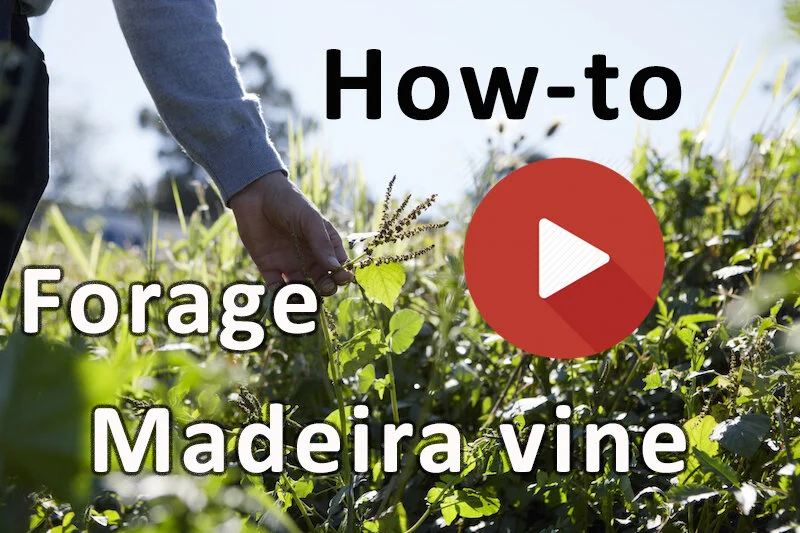How yummy is this weed? Madeira vine, the edible menace
Every now and then I bring people’s attention to Madeira vine, Anredera cordifolia.
This rampant climber is a serious pest. It grows to biblical proportions scrambling over bushes and even climbs trees up to 20 meters tall, and because it is heavy and prolific, it eventually brings them down.
Incredible to witness, see the images below for some visuals of infestations all along the East Coast of Australia (from Tasmania all the way up to Cairns) but also in South Australia around Adelaide and the region around Perth.
This plant is heavily legislated against as it proliferates in disrupted native vegetation where it smothers and kills plants from ground covers to tall trees. The Biosecurity Act 2015 has a lot to say about this plant and depending on where you live, it prohibits the sale and dispersal of it.
There have been various attempts at controlling this rampant weed, including introducing leaf cutters (which are little bugs that love to eat it) as a biological control. I think we should take note of these little creatures and chomp on the leaves ourselves too!
What is Madeira vine?
Madeira vine is a vigorous climber with fleshy heart-shaped leaves. It is originally from South America and has been recorded in Australia as far back as the 1910s, originally introduced as a garden plant for its prolific growth and scented flowers. It produces long tentacles that coil themselves on nearby vegetation and ‘climb’, in order to reach for better sun exposure. Eventually, the leaves cover the whole area impeding the host planta ability to get sun, which in due course kills it. Madeira vine can live for several years and reproduces by the offshoots of its roots or by the signature aerial roots ( bulbis) when they drop to the floor and start a new plant. It is most common in wet gullies and can tolerate quite a range of temperatures. It seems that it does not produce viable seeds in Australia.
Leaves and branches
The leaves are the most recognisable feature of the plant. They are evergreen, glossy and heart-shaped, up to 15 cm wide. In colder climates, it slows down the growth, but in most other environments it keeps expanding and producing new leaflets. The leaves are quite fleshy, at times 3-4mm thick, and brittle. The branches look like tentacles, reaching out for anything to climb on. It is common to see the branches turning red when the plant is stressed by temperature or lack of water. They can get quite thick, up to 4-5mm in diameter, and are quite strong, with a tough internal core that is hard to break. If you pull down on a branch of Madeira you are likely to pull down the branch of the tree that it is climbing on too. It forms several, amorphous ‘areal roots’ along the older branches that can easily drop to the floor when you try to pull the vines. See images.
Flowers and fruits
The flowers are very showy, white to cream, sweet scented and appearing in drooping clusters, like the tail of a cat ( racemes)
Roots
The roots look like warts, branching out and growing even above ground. They are easily broken and each segmnet can regrow into a new plant. They are dark brown and fleshy, up to 6-8cm wide.
How to cook Madeira vine
In my opinion, the best part is the leaves, fried in a little oil until the liquid is reduced then served with chilly paste.
Have a look at the video that Gabriel from Ziggy Wild Foods and I made of the leaves we fried up in my backyard: delicious!
In Japan, they know it as okawakame ( land seaweed) and serve it as a side dish, just simply boiled or fresh in salads. It is regarded as a superfood there. It is also very much appreciated in Korea, Taiwan and China. Please note that excessive consumption of fresh parts of Madeira vine might cause diarrhoea.
Medicinal properties
Madeira vine is regarded as an important medicine in Eastern herbalism, known in China as the Hundred medicine of Yunnan.
Interesting to note that the majority of medicinal properties are not recorded from South America but from thousands of years of usage in Southern China, Vietnam and Indonesia. If you’re up for a nerdy read I suggest this article as a fantastic monograph of the plant. In Vietnam this plant came to be a hero of the resistance war in the 60-70’s, as the soldiers used it to heal the wounds, and they ate it too. It was so effective that the government declared the plant an important food source. Here you can access a peer reviewed article substantiating the beneficial effects of the plant in healing skin wounds and burns and here an extensive review of the medicinal properties of the plant as reported by a South American study . Madeira vine is very nutritious and contains high quantities of Calcium, vitamins A, and vitamin E. What a little champion of a plant!
The issue with weeds
Madeira vine is highly contested, but love it or hate it is a part of this country’s new ecology. I can imagine lots of people rolling their eyes at the thought that you would do anything but kill this plant in Australia, and yet this is a widely abundant and desirable vegetable, highly adapted and needs little to no effort to grow. Even if you want to eradicate it, why waste a perfectly good and nutritious food source?
The bottom line here is: we spend lots of effort, money and time to grow food in this country that is effectively destroying the ecosystem ( wheat, rice, corn, and so forth) due to the exploitative agricultural dogma of monoculture. At the same time, we spend lots of time, money and effort in eradicating perfectly good edible species from our native ecologies, by applying herbicides and destroying the produce. This questioning of mine has been going on for years, and Madeira vine is a point in case that cannot be ignored.
Join your local bush regenerator group and eradicate this pest. While you’re at it eat it too.
DISCLAIMER: This information should be used as a guide only. It is not my intention to advise anyone on medical conditions, rather, I am presenting a new way to look at the plants growing in your yard.
Let me help you help yourself: if you are unsure about the identity of your plants tag me in a picture or comment below, and I’ll endeavour to help.
This article is one of the many published in my book: Eat Weeds. Out now>
Further Reading
www.cabi.org Madeira vine as invasive species
www.researchgate.net Review of medicinal properties of Madeira vine
www.ncbi.nlm.nih.gov Scientific paper about the efficacy of Madeira vine for burns
pfaf.org Plant for a Future Report on Madeira vine
avrdc.org World Vegetable Centre Report on Madeira vine
www.eattheweeds.com Deane on Madeira vine
www.milkwood.net Milkwood on Madeira vine
en.wikipedia.org Wikipedia on Madeira vine
profiles.ala.org.au Weed of National Significance report
avh.ala.org.au Madeira vine distribution Australia
www.researchgate.net A thorough report on the impact of this plant on Australian ecologies
herbsfromdistantlands.blogspot.com Excellent review of the history, ethnobotany and medicinal properties..










